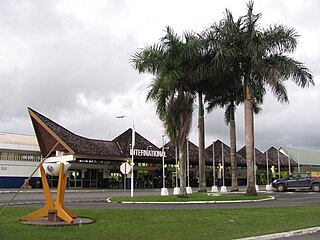
Bauerfield International Airport is an airport located in Port Vila, Vanuatu. The airport is relatively small in size, but its runway has the capability and length to accept jets up to the Airbus A330. It serves as the hub for Vanuatu's flag carrier airline, Air Vanuatu.

Espiritu Santo is the largest island in the nation of Vanuatu, with an area of 3,955.5 km2 (1,527.2 sq mi) and a population of around 40,000 according to the 2009 census.
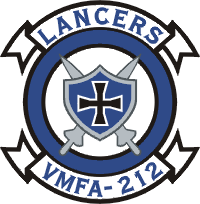
Marine Fighter Attack Squadron 212 (VMFA-212) was a United States Marine Corps F/A-18 Hornet squadron. Most recently known as the "Lancers", the squadron was last based at Marine Corps Air Station Iwakuni, Japan and fell under the command of Marine Aircraft Group 12 (MAG-12) and the 1st Marine Aircraft Wing. Due to a re-organization within Marine aviation, the squadron was deactivated in 2008. It is scheduled to be reactivated as an MV-22B squadron in 2019 under MAG 26 at MCAS New River, NC.

Marine Fighter Attack Squadron 112 (VMFA-112) is a reserve United States Marine Corps McDonnell-Douglas F/A-18 Hornet squadron. The squadron is based at NASJRB Fort Worth, Texas and falls under the command of Marine Aircraft Group 41 (MAG-41), 4th Marine Aircraft Wing. Their tail code is MA. During World War II the squadron saw extensive action throughout the Pacific Theater of Operations especially at the Battle of Guadalcanal as part of the Cactus Air Force. By the end of the war, its 140 air-to-air kills ranked it third among Marine Corps squadrons.

Port Havannah is a port village on Efate Island in Vanuatu.

Nissan Island Airport is an airfield serving Nissan Island, in the Autonomous Region of Bougainville in Papua New Guinea. It resides at an elevation of 100 feet (30 m) above mean sea level and has a 1,200-metre (3,937 ft) runway designated 14/32.

Santo-Pekoa International Airport is an airport in Luganville on Espiritu Santo in Vanuatu. Airports Vanuatu Limited provides aviation services for the airport.
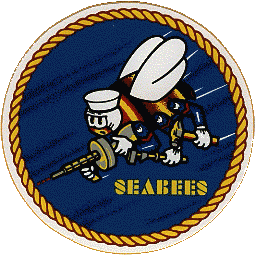
When World War II broke out the United States Naval Construction Battalions (Seabees) did not exist. The logistics of a two theater war were daunting to conceive. Rear Admiral Moreell completely understood the issues. What needed to be done was build staging bases to take the war to the enemy, across both oceans, and create the construction force to do the work. Naval Construction Battalions were first conceived at Bureau of Yards and Docks (BuDocks) in the 1930s. The onset of hostilities clarified to Radm. Moreell the need for developing advance bases to project American power. The solution: tap the vast pool of skilled labor in the U.S. Put it in uniform to build anything, anywhere under any conditions and get the Marine Corps to train it. The first volunteers came skilled. To obtain these tradesmen, military age was waived to age 50. It was later found that several past 60 had managed to get in. Men were given advanced rank/pay based upon experience making the Seabees the highest paid group in the U.S. military. The first 60 battalions had an average age of 37.

Marine Fighting Squadron 215 (VMF-215) was a fighter squadron of the United States Marine Corps that was commissioned and fought during World War II. Known as "The Fighting Corsairs", the squadron fought in many areas of the Pacific War, including the Battle of Bougainville. During its four-and-a-half month tour, the squadron was credited with shooting down 137 enemy aircraft, fourth most in Marine Corps aviation history.

Quoin Hill Airfield was an airfield in North Efate, in Vanuatu. The airfield was used during World War II but is no longer usable as an airstrip.

Luganville Airfield or Bomber Field #3 is a former World War II airfield on the island of Espiritu Santo in the New Hebrides Islands at the Espiritu Santo Naval Base.
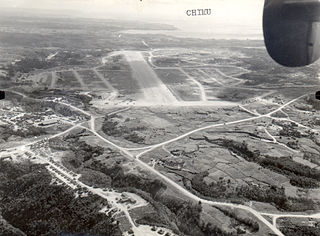
Chimu Airfield or NAB Chimu is a former World War II airfield on the Pacific coast of Okinawa. The airfield was inactivated after October 1945.
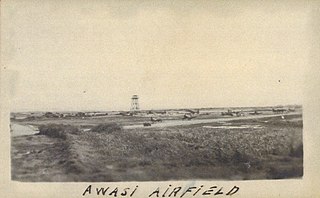
Awase Airfield or NAB Awase is a former World War II airfield on the Pacific coast of Okinawa.

Majuro Airfield or Naval Air Facility Majuro is a former World War II airfield on the island of Delap in the Marshall Islands.

Palikulo Bay Airfield or Bomber Field #1 is a former World War II airfield on the island of Espiritu Santo in the New Hebrides Islands at the Espiritu Santo Naval Base.

Luganville Seaplane Base is a former World War II seaplane base in the Segond Channel between the islands of Espiritu Santo and Aore Island in the New Hebrides Islands at the Espiritu Santo Naval Base.
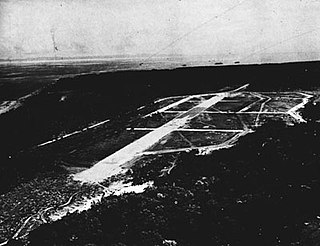
Kukum Field also known as Fighter 2 Airfield is a former World War II airfield on Guadalcanal, Solomon Islands.
VPB-54 was a Patrol Bombing Squadron of the U.S. Navy. The squadron was established as Patrol Squadron 54 (VP-54) on 15 November 1942, redesignated Patrol Bombing Squadron 54 (VPB-54) on 1 October 1944 and disestablished on 7 April 1945.

Naval Advance Base Espiritu Santo or Espiritu Santo Naval Base, most often just called Espiritu Santo, was an advance Naval base that the U.S. Navy Seabees built during World War II to support the allied effort in the Pacific. Espiritu Santo Naval Base was located on the island Espiritu Santo in the New Hebrides, now Vanuatu in the South Pacific. The base also supported the U.S. Army and Army Air Corps, U.S. Coast Guard, and US Marine Corps. Espiritu Santo Naval Base was the first large advance base built in the Pacific. By the end of the war it had become the second-largest base in the theater. To keep ships tactically available there was a demand for Advance bases that could repair and resupply the fleet at advance locations, rather than bring ships back to the United States. Prior to December 7th, Pearl Harbor was the U.S. fleet's largest advance base in the Pacific. Espiritu became, capable of all aspects necessary to support the Fleet's operations from fleet logistics in fuel, food, and ammo, to transport embarkation for combat operations or returning to CONUS. The ships repair facilities, and drydocks were capable of attending to most damage and routine maintenance. Had it not existed, ships would have had to return to Pearl Harbor, Brisbane,or Sydney for major repairs and resupply. The base became a major R and R destination for the fleet.

US Naval Advance Bases are a number of United States Navy Naval bases built during World War 2 around the world to support the many naval war ships and boats fighting the global war. A few were built at US Allies ports, but most were built at ports captured from the rival armies of the US. In order to keep ships tactically available there was a great demand for bases that could repair and supply ships in theater, rather than return them to CONUS.Before Japan declared war on the United States the US Navy's only fully equipped advanced base was Naval Station Pearl Harbor in the Territory of Hawaii. During the war the US Navy built over 400 advance bases in the Atlantic Theater of Operations and Pacific Theater of Operations. Advance based were categorized by size. Naval bases were either Lions or Cubs. Airfields were either Oaks or Acorns. Some Advance Bases were small and only supported a few PT Boats, others were very large and could support a fleet of ships. Some of the Advance Bases also had airbases. Most bases could do refueling and overhaul; loading of troopship and cargo ships; and preparing amphibious assault ships. Some of the remote ports also became major repair depots. Advanced auxiliary floating drydocks were able to repair battle damage and do regular maintenance in the field. These ships otherwise would have returned to continental bases or Pearl Harbor. The bases also were a place for the troops to rest and regroup. Most Advance Bases were built by the US Navy's Seabees in Naval Construction Battalions (CBs). At the start of the war some civilian contractor were employed in construction. The Seabees in World War II built most of the airfields used by the United States Army Air Forces and United States Marine Corps, as they had the ships and cranes needed to transport the vast amount of equipment needed at the advance bases. The US Army and United States Coast Guard also operated out of many of these facilities. Seabees could build new or repair damaged runways, and with advancements heavy bomber technology lengthen as needed. A few Naval Advance Bases were built for the Korean War and Vietnam War.





















